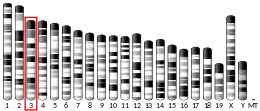KCNMB3
Calcium-activated potassium channel subunit beta-3 is a protein that in humans is encoded by the KCNMB3 gene.[5][6]
| KCNMB3 | |||||||||||||||||||||||||||||||||||||||||||||||||||
|---|---|---|---|---|---|---|---|---|---|---|---|---|---|---|---|---|---|---|---|---|---|---|---|---|---|---|---|---|---|---|---|---|---|---|---|---|---|---|---|---|---|---|---|---|---|---|---|---|---|---|---|
| Identifiers | |||||||||||||||||||||||||||||||||||||||||||||||||||
| Aliases | KCNMB3, BKBETA3, HBETA3, K(VCA)BETA-3, KCNMB2, KCNMBL, SLO-BETA-3, SLOBETA3, potassium calcium-activated channel subfamily M regulatory beta subunit 3 | ||||||||||||||||||||||||||||||||||||||||||||||||||
| External IDs | OMIM: 605222 MGI: 3612244 HomoloGene: 18141 GeneCards: KCNMB3 | ||||||||||||||||||||||||||||||||||||||||||||||||||
| |||||||||||||||||||||||||||||||||||||||||||||||||||
| |||||||||||||||||||||||||||||||||||||||||||||||||||
| |||||||||||||||||||||||||||||||||||||||||||||||||||
| |||||||||||||||||||||||||||||||||||||||||||||||||||
| |||||||||||||||||||||||||||||||||||||||||||||||||||
| Wikidata | |||||||||||||||||||||||||||||||||||||||||||||||||||
| |||||||||||||||||||||||||||||||||||||||||||||||||||
MaxiK channels are large conductance, voltage and calcium-sensitive potassium channels which are fundamental to the control of smooth muscle tone and neuronal excitability. MaxiK channels can be formed by 2 subunits: the pore-forming alpha subunit and the modulatory beta subunit. The protein encoded by this gene is an auxiliary beta subunit which may partially inactivate or slightly decrease the activation time of MaxiK alpha subunit currents. At least four transcript variants encoding four different isoforms have been found for this gene.[6]
References
- GRCh38: Ensembl release 89: ENSG00000171121 - Ensembl, May 2017
- GRCm38: Ensembl release 89: ENSMUSG00000091091 - Ensembl, May 2017
- "Human PubMed Reference:". National Center for Biotechnology Information, U.S. National Library of Medicine.
- "Mouse PubMed Reference:". National Center for Biotechnology Information, U.S. National Library of Medicine.
- Riazi MA, Brinkman-Mills P, Johnson A, Naylor SL, Minoshima S, Shimizu N, Baldini A, McDermid HE (Feb 2000). "Identification of a putative regulatory subunit of a calcium-activated potassium channel in the dup(3q) syndrome region and a related sequence on 22q11.2". Genomics. 62 (1): 90–4. doi:10.1006/geno.1999.5975. PMID 10585773.
- "Entrez Gene: KCNMB3 potassium large conductance calcium-activated channel, subfamily M beta member 3".
Further reading
- Orio P, Rojas P, Ferreira G, Latorre R (2002). "New disguises for an old channel: MaxiK channel beta-subunits". News Physiol. Sci. 17 (4): 156–61. doi:10.1152/nips.01387.2002. hdl:10533/173696. PMID 12136044.
- Brenner R, Jegla TJ, Wickenden A, et al. (2000). "Cloning and functional characterization of novel large conductance calcium-activated potassium channel beta subunits, hKCNMB3 and hKCNMB4". J. Biol. Chem. 275 (9): 6453–61. doi:10.1074/jbc.275.9.6453. PMID 10692449.
- Liu QH, Williams DA, McManus C, et al. (2000). "HIV-1 gp120 and chemokines activate ion channels in primary macrophages through CCR5 and CXCR4 stimulation". Proc. Natl. Acad. Sci. U.S.A. 97 (9): 4832–7. Bibcode:2000PNAS...97.4832L. doi:10.1073/pnas.090521697. PMC 18318. PMID 10758170.
- Uebele VN, Lagrutta A, Wade T, et al. (2000). "Cloning and functional expression of two families of beta-subunits of the large conductance calcium-activated K+ channel". J. Biol. Chem. 275 (30): 23211–8. doi:10.1074/jbc.M910187199. PMID 10766764.
- Meera P, Wallner M, Toro L (2000). "A neuronal beta subunit (KCNMB4) makes the large conductance, voltage- and Ca2+-activated K+ channel resistant to charybdotoxin and iberiotoxin". Proc. Natl. Acad. Sci. U.S.A. 97 (10): 5562–7. Bibcode:2000PNAS...97.5562M. doi:10.1073/pnas.100118597. PMC 25868. PMID 10792058.
- Behrens R, Nolting A, Reimann F, et al. (2000). "hKCNMB3 and hKCNMB4, cloning and characterization of two members of the large-conductance calcium-activated potassium channel beta subunit family". FEBS Lett. 474 (1): 99–106. doi:10.1016/S0014-5793(00)01584-2. PMID 10828459. S2CID 32791798.
- Xia XM, Ding JP, Zeng XH, et al. (2000). "Rectification and rapid activation at low Ca2+ of Ca2+-activated, voltage-dependent BK currents: consequences of rapid inactivation by a novel beta subunit". J. Neurosci. 20 (13): 4890–903. doi:10.1523/JNEUROSCI.20-13-04890.2000. PMC 6772275. PMID 10864947.
- Lingle CJ, Zeng XH, Ding JP, Xia XM (2001). "Inactivation of BK channels mediated by the NH(2) terminus of the beta3b auxiliary subunit involves a two-step mechanism: possible separation of binding and blockade". J. Gen. Physiol. 117 (6): 583–606. doi:10.1085/jgp.117.6.583. PMC 2232400. PMID 11382808.
- Zeng XH, Ding JP, Xia XM, Lingle CJ (2001). "Gating properties conferred on BK channels by the beta3b auxiliary subunit in the absence of its NH(2)- and COOH termini". J. Gen. Physiol. 117 (6): 607–28. doi:10.1085/jgp.117.6.607. PMC 2232397. PMID 11382809.
- Strausberg RL, Feingold EA, Grouse LH, et al. (2003). "Generation and initial analysis of more than 15,000 full-length human and mouse cDNA sequences". Proc. Natl. Acad. Sci. U.S.A. 99 (26): 16899–903. Bibcode:2002PNAS...9916899M. doi:10.1073/pnas.242603899. PMC 139241. PMID 12477932.
- Zeng XH, Xia XM, Lingle CJ (2003). "Redox-sensitive extracellular gates formed by auxiliary beta subunits of calcium-activated potassium channels". Nat. Struct. Biol. 10 (6): 448–54. doi:10.1038/nsb932. PMID 12740608. S2CID 19557594.
- Hu S, Labuda MZ, Pandolfo M, et al. (2003). "Variants of the KCNMB3 regulatory subunit of maxi BK channels affect channel inactivation". Physiol. Genomics. 15 (3): 191–8. doi:10.1152/physiolgenomics.00110.2003. PMID 14612589.
- Lorenz S, Heils A, Kasper JM, Sander T (2007). "Allelic association of a truncation mutation of the KCNMB3 gene with idiopathic generalized epilepsy". Am. J. Med. Genet. B Neuropsychiatr. Genet. 144 (1): 10–3. doi:10.1002/ajmg.b.30369. PMID 16958040. S2CID 29047028.
This article incorporates text from the United States National Library of Medicine, which is in the public domain.




